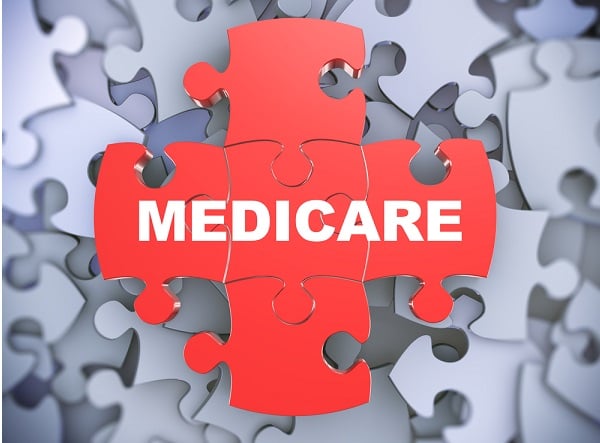 The continuing rising cost of health care has more individuals scrutinizing their options, and Medicare is finally garnering the attention it deserves. (Photo: Shutterstock)
The continuing rising cost of health care has more individuals scrutinizing their options, and Medicare is finally garnering the attention it deserves. (Photo: Shutterstock)
Medicare is a complicated federal benefit to understand, but an important area of concern for large employers given today's workforce characteristics. More Americans are choosing to keep working well beyond their 65th birthday, and the Bureau of Labor Statistics (BLS) predicts that 36 percent of 65- to 69-year-old Americans will be a part of the workforce in 2024.
As workers move into what we used to think of as the retirement years, they and their employers have choices to make about health insurance. This is especially true as employers experience a larger mix of both post-65 active employees and post-65 retirees. These are two very different populations, with different needs—but both seeing potential benefits with access to expert Medicare plan assistance.
Despite the assumption that employer-provided coverage is always “best,” it turns out Medicare might actually provide these populations with better benefits at a lower cost. Employees who are being advised to work longer and find more ways to sock away savings for their retirement years also could heed the availability of Medicare as an important avenue for cost savings as health care inflation affects more households.
First, some background: For individuals to qualify for Medicare coverage, they generally must be at least 65 years old (those who receive Social Security Disability benefits may be eligible, not matter their age); a U.S. citizen or permanent resident of the U.S. for the last five years; and have paid Medicare taxes for 10 years themselves, or be married to someone who has. Unless they have already applied for and been receiving Social Security, Medicare enrollment isn't automatic.
Let's take a look at each of these groups for large employers:
|Employees who work past 65
It's easy enough to put off dealing with Medicare choices for individuals working past 65. Employers are required to offer all of their active employees group health plan coverage—which means post-65 active workers have the benefit of continuing their employer coverage. In addition, many employees choose to continue with employer coverage because they need spouse and dependent health care coverage.
However, a portion of these individuals may be missing out on significant savings when delaying their transition to Medicare, and pushing the decision until after they leave their employer.
A brief comparison of prices tells the story. The average annual deductible that a single employee on their employer's plan has to hit before coverage kicks in is $1,573, according to Kaiser Family Foundation's 2018 Employer Health Benefits Survey. Meanwhile, the average annual Medicare Part B deductible is just $185, and Medicare Part A is generally premium-free. (Note: When employees do leave their place of employment, they are required to enroll in Medicare Part B coverage within eight months to avoid penalties.)
|Retirees using employer coverage
At the same time, employers also may provide retiree health care coverage through their group health plan program. These individuals could be missing out on the same type of health care savings because they continue with employer-provided coverage, rather than enrolling in Medicare.
Employer-provided health care coverage for retirees is becoming less common among employers, with an estimated 18 percent of employers offering the coverage in 2018, down from 25 percent in 2017. Even so, many individuals are choosing their employer-offered retiree health plans—not realizing this buying decision could be eating into their retirement future due to higher, unnecessary health care costs.
The continuing rising cost of health care has more individuals and organizations scrutinizing their options, and Medicare, which has been widely overlooked or bypassed in the past is finally garnering the attention it deserves.
|Exploring alternatives with Medicare
An important sticking point for most people is that Medicare carries complexities. It can seem safer to stay out of the Medicare arena, if that's an option, because someone is still working and has access to employer health care. For instance, there are rules regarding the timing of Medicare enrollment and penalties. Whereas, post-65 active workers who still receive employer health insurance don't face these same requirements or penalties.
Understandably, employers are not in the habit of thinking about Medicare and how it may benefit their workers and organization. Historically, Medicare has been a post-work retirement topic—not a topic for the water cooler. But with workers ages 65-74 and older expected to see faster rates of labor force growth the next five years, it makes sense for employers to start examining the value of Medicare Plan Selection services as a part of their benefits and compensation package.
Employers who appreciate the complexities involved with benefits coordination issues around Medicare will enjoy loyalty from those older, talented professionals who receive specialized guidance through this complicated time of transition in their health care choices—and watch the value build as the U.S. workforce continues to grow older.
Complete your profile to continue reading and get FREE access to BenefitsPRO, part of your ALM digital membership.
Your access to unlimited BenefitsPRO content isn’t changing.
Once you are an ALM digital member, you’ll receive:
- Breaking benefits news and analysis, on-site and via our newsletters and custom alerts
- Educational webcasts, white papers, and ebooks from industry thought leaders
- Critical converage of the property casualty insurance and financial advisory markets on our other ALM sites, PropertyCasualty360 and ThinkAdvisor
Already have an account? Sign In Now
© 2024 ALM Global, LLC, All Rights Reserved. Request academic re-use from www.copyright.com. All other uses, submit a request to [email protected]. For more information visit Asset & Logo Licensing.








